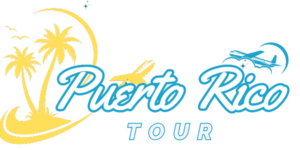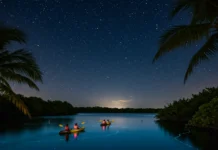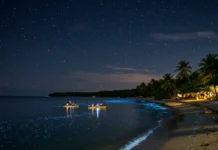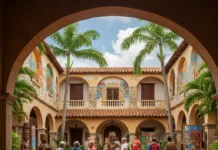Introduction to Puerto Rico’s Rich History
Puerto Rico stands as a living testament to centuries of cultural evolution, conquest, and resilience. Its historical places are layered with stories of indigenous civilizations, Spanish colonial power, and modern transformations, each leaving a distinct mark on the island’s landscape and identity. Exploring these sites allows us to connect with the soul of Puerto Rico, where cobblestone streets, vibrant plazas, and weathered fortresses echo with the footsteps of those who shaped its destiny.
From the imposing stone walls of Old San Juan to the tranquil highland towns, every corner offers a unique chapter in the narrative of this Caribbean treasure. The island’s historical places not only tell the story of Puerto Rico, but also invite us to reflect on the broader currents of history that have influenced the Americas.
Why Visit Puerto Rico’s Historical Sites?
Visiting Puerto Rico’s historical sites offers more than a lesson in history—it’s an invitation to witness living heritage. These locations provide insight into the diverse influences that have shaped the island, from the Taíno people to Spanish settlers and beyond. Walking through these sites, we experience the blend of old and new, where centuries-old architecture stands alongside vibrant modern culture.
Many travelers seek out Puerto Rico’s historic treasures to better understand the island’s unique blend of traditions, languages, and architectural styles. For those eager to uncover lesser-known stories, our overview of hidden history tours provides inspiration for a deeper exploration beyond the well-trodden paths.
How to Plan Your Historical Tour of Puerto Rico
A well-planned historical tour of Puerto Rico requires thoughtful preparation. The island’s top sites are distributed across various regions, each with its own climate, accessibility, and unique highlights. Prioritizing based on your interests—whether colonial forts, indigenous heritage, or architectural marvels—will help maximize your experience.
Best Times of Year to Visit Historical Places in Puerto Rico
The optimal period for exploring historical places in Puerto Rico is between December and April, when the weather is pleasantly warm and rainfall is minimal. This dry season brings gentle breezes and clear skies, ideal for walking tours and outdoor attractions. However, popular sites can become busy during this time, especially around holidays.
Travelers seeking quieter experiences might consider visiting during the shoulder seasons in late spring or early autumn, when crowds thin and the island’s lush landscapes are at their most vibrant.
What to Pack for Exploring Historical Sites?
When preparing for a day among Puerto Rico’s historic landmarks, comfort and practicality should guide your packing list. We recommend:
- Lightweight, breathable clothing to stay cool under the Caribbean sun
- Comfortable walking shoes for cobblestone streets and uneven terrain
- Sun protection—hat, sunglasses, and reef-safe sunscreen
- A reusable water bottle to stay hydrated
- Compact rain gear, especially during the summer months
A small daypack is also useful for carrying maps, a camera, and any souvenirs picked up along the way.
Understanding Puerto Rico’s Cultural Heritage
To fully appreciate Puerto Rico’s historical sites, it’s essential to understand the cultural tapestry that has shaped the island. From ancient ceremonial centers to grand colonial plazas, every location reflects the interplay of indigenous, European, and American influences.
A Brief Timeline of Puerto Rican History
Puerto Rico’s history unfolds across several key eras. The earliest inhabitants, the Taíno people, established thriving societies long before Spanish arrival in 1493. The island became a crucial outpost in Spain’s New World empire, enduring centuries of colonial rule until the Spanish-American War of 1898, when it became a territory of the United States. The 20th and 21st centuries have witnessed profound social and political changes, producing the vibrant Puerto Rico we see today.
Indigenous Roots: The Taíno Legacy
The Taíno legacy endures in Puerto Rican culture, language, and traditions. Their agricultural knowledge, spiritual beliefs, and artistry are preserved in archaeological sites and museums throughout the island. Visitors can view remarkable petroglyphs, ceremonial plazas, and artifacts that offer a glimpse into the island’s original inhabitants.
Spanish Colonial Influence
Much of Puerto Rico’s architectural splendor stems from its period as a Spanish colony. Massive fortifications, ornate churches, and stately mansions reflect centuries of European influence. The Spanish language, Catholic faith, and culinary traditions remain deeply rooted in daily life, blending with local customs to create a uniquely Puerto Rican identity.
For those interested in the lesser-known stories of this era, our article on hidden cultural tours in Puerto Rico highlights experiences that bring colonial history to life.
American Era and Modern Developments
The transition to American governance brought new influences, including shifts in architecture, infrastructure, and education. Today, Puerto Rico balances its rich heritage with contemporary innovation, as seen in the restoration of historic districts and the celebration of multicultural festivals.
Modern developments coexist with centuries-old landmarks, inviting visitors to witness the ongoing evolution of Puerto Rican society.
Old San Juan: A Historical Treasure
No historical exploration of Puerto Rico would be complete without a visit to Old San Juan. This UNESCO World Heritage Site is a labyrinth of pastel-hued buildings, imposing fortresses, and lively plazas, all set atop a dramatic headland overlooking the Atlantic Ocean.
The district’s cobblestone streets are alive with the sounds of local musicians, the aroma of street food, and the sight of intricate balconies draped in bougainvillea. Every step reveals layers of history, artistry, and community spirit.
Why is Old San Juan a Must-Visit?
Old San Juan transports visitors into the heart of Puerto Rico’s colonial past. Its well-preserved architecture and vibrant street life create an immersive experience, where centuries-old churches and bustling cafes share the same block. The area is compact and walkable, making it easy to experience multiple attractions in a single day.
Travelers seeking unique perspectives on the city’s hidden stories can explore our recommendations for off-the-beaten-path tours in Old San Juan.
Castillo San Felipe del Morro
Rising majestically above the Atlantic, Castillo San Felipe del Morro—known simply as El Morro—stands as one of Puerto Rico’s most iconic landmarks. This imposing fortress has guarded San Juan Bay for over 400 years, with its thick stone walls and sweeping ocean views captivating generations of visitors.
History and Architecture of El Morro
Construction of El Morro began in 1539, and over the centuries, it was expanded to withstand attacks by pirates and rival empires. The fortress features dramatic ramparts, sentry boxes called garitas, and a labyrinth of tunnels and dungeons. Its strategic position and innovative design made it virtually impregnable, earning it a place among the most significant military structures in the Caribbean.
Tips for Visiting El Morro
To make the most of your visit to El Morro, arrive early to avoid crowds and enjoy the cooler morning breezes. Bring a hat and sunscreen, as the open spaces atop the fortress are sun-drenched. Don’t miss the panoramic views of the Atlantic crashing against the cliffs, and take time to explore the museum exhibits inside.
Kites dot the sky above El Morro’s sprawling lawns—consider bringing your own or simply watch as families enjoy this cherished local pastime.
Castillo San Cristóbal
Just east of El Morro, Castillo San Cristóbal boasts the title of the largest fortification built by the Spanish in the New World. Its massive walls and maze-like corridors once protected San Juan from land-based attacks.
Defensive Role of San Cristóbal
San Cristóbal was constructed to defend against intruders approaching from the east, and its intricate system of tunnels, moats, and outworks demonstrates advanced military engineering. The fort’s vantage points offer sweeping views of the city, harbor, and surrounding coastline.
What to See Inside San Cristóbal?
Visitors can explore original cannons, barracks, and secret escape tunnels. Informative displays recount dramatic sieges and the daily lives of soldiers stationed there. The echo of footsteps on ancient stone and the scent of salt air create an atmosphere both solemn and awe-inspiring.
La Fortaleza and San Juan National Historic Site
La Fortaleza, the oldest executive mansion in continuous use in the Western Hemisphere, is a striking blue structure set above the city walls. Together with the city’s two major forts, it forms the San Juan National Historic Site, a UNESCO World Heritage Site that preserves Puerto Rico’s colonial legacy.
The Blue Mansion: History and Tours
Built in the 16th century as a fortress, La Fortaleza has served as the governor’s residence for over 400 years. Guided tours reveal elegant salons, lush gardens, and stories of political intrigue. The mansion’s pastel façade gleams under the Caribbean sun, while its interiors house antique furnishings and priceless artwork.
Walking the Colorful Streets of Old San Juan
Strolling through Old San Juan, we are greeted by a kaleidoscope of color—brilliant facades, hand-carved doors, and wrought-iron balconies adorned with flowers. The neighborhood’s lively rhythm is punctuated by the sound of horse-drawn carriages and the hum of conversation in shaded plazas.
Notable Plazas and Monuments
Key gathering places include Plaza de Armas, the social heart of the city, and Plaza Colón, crowned by a statue of Christopher Columbus. Monuments throughout the district honor poets, revolutionaries, and artists, inviting reflection on Puerto Rico’s diverse history.
Iglesia de San José
Overlooking a quiet plaza, Iglesia de San José is one of the oldest churches in the Americas. Its simple Gothic design and whitewashed walls radiate serenity, offering a peaceful retreat from the city’s bustle.
The Oldest Church in San Juan
Completed in 1532, the church has witnessed centuries of weddings, baptisms, and historic events. Restoration efforts have uncovered original frescoes and preserved ancient masonry, allowing visitors to appreciate both its spiritual and architectural significance.
Paseo de la Princesa
This tree-lined promenade stretches from the city walls toward the sea, shaded by palms and dotted with sculptures. The gentle breeze carries the scent of tropical flowers and the distant melody of street performers.
History and Modern-Day Attractions
Originally constructed in the 19th century, Paseo de la Princesa was once the site of city celebrations and parades. Today, it hosts craft markets, art exhibits, and open-air cafes, blending history with contemporary charm.
Ponce: The Pearl of the South
On Puerto Rico’s southern coast lies Ponce, a city renowned for its neoclassical architecture, dynamic arts scene, and pivotal role in the island’s history. Known as “La Perla del Sur,” Ponce offers a striking contrast to San Juan, with grand plazas and ornate facades reflecting its prosperous past.
How Did Ponce Shape Puerto Rican History?
Ponce flourished as a center of commerce, culture, and political activism. Its citizens played crucial roles in the abolition of slavery, the fight for autonomy, and the development of Puerto Rican identity. The city’s elegant avenues and museums preserve the stories of generations who contributed to the island’s progress.
Parque de Bombas
The Parque de Bombas firehouse, painted in bold red and black stripes, is one of Puerto Rico’s most photographed landmarks. Its whimsical appearance belies a rich history of public service and civic pride.
The Iconic Red and Black Firehouse
Built in 1882 for an exhibition, the firehouse soon became the headquarters for Ponce’s volunteer firefighters. Its wooden construction and Moorish-inspired design make it a singular piece of Caribbean architecture. Today, the building houses a museum celebrating the bravery of the city’s firemen.
Museo de la Historia de Ponce
This comprehensive museum chronicles the evolution of Ponce from a rural outpost to a cosmopolitan hub. Interactive exhibits and immersive displays highlight the city’s economic, social, and artistic milestones.
What Can You Learn at the Ponce History Museum?
Visitors can trace the city’s growth through artifacts, photographs, and multimedia presentations. Topics span from indigenous settlements and colonial rule to industrialization and the modern era, offering a nuanced perspective on Puerto Rico’s “Pearl of the South.”
Plaza Las Delicias and Surroundings
At the heart of Ponce lies Plaza Las Delicias, a leafy square surrounded by stately buildings and lively cafes. The plaza is a favorite gathering spot for locals and tourists alike, where the scent of roasting coffee mingles with the sound of church bells.
Cathedral of Our Lady of Guadalupe
This majestic cathedral, with its twin towers and neoclassical façade, dominates the plaza. Inside, soaring ceilings and stained-glass windows create a space of tranquility and devotion, echoing centuries of faith.
Casa Armstrong-Poventud
A short stroll from the plaza brings visitors to Casa Armstrong-Poventud, an exquisite example of 19th-century urban residence. The mansion’s ornate ironwork, marble floors, and period furnishings transport guests to a bygone era.
Exploring Ponce’s Historic Homes
Guided tours reveal the stories of the influential families who shaped Ponce’s development. The home’s blend of European and Caribbean elements reflects the city’s cosmopolitan character and enduring appreciation for beauty and craftsmanship.
Arecibo and the Northern Coast
Puerto Rico’s northern coast is dotted with sites that illuminate its indigenous and colonial past. Arecibo, in particular, offers a mix of dramatic coastal scenery and historical intrigue, from lighthouses to ancient caves etched with Taíno art.
Arecibo Lighthouse & Historical Park
Perched atop a rugged promontory, the Arecibo Lighthouse beckons with panoramic views of the Atlantic and exhibits that trace the island’s maritime history. The adjacent park features recreated Taíno villages and pirate ships, making it a favorite for families and history enthusiasts.
What’s Inside the Arecibo Lighthouse?
Inside the lighthouse, visitors encounter displays on navigation, shipwrecks, and the evolution of Puerto Rican coastal defenses. The scent of salt air and the sound of waves crashing below evoke the dangers faced by mariners throughout the centuries.
Cueva del Indio: Ancient Petroglyphs
Just west of Arecibo, Cueva del Indio is a coastal cave adorned with mysterious petroglyphs carved by the Taíno people. The cave’s dramatic setting—waves surging against limestone cliffs—adds a sense of wonder to this archaeological treasure.
Exploring Taíno Rock Art
Guided tours reveal intricate carvings depicting animals, faces, and geometric patterns. These symbols offer a window into the spiritual life and cosmology of Puerto Rico’s earliest inhabitants. For those planning to visit, our feature on adventures at Indian Cave provides practical tips and fascinating background.
Camuy River Cave Park
The Camuy River Cave Park is one of the largest cave networks in the Western Hemisphere. Exploring its subterranean chambers, we experience the cool hush of ancient geology and the wonder of underground rivers.
Historical Significance of Camuy Caves
These caves were used by indigenous peoples for shelter and ceremonial purposes. Interpretive centers and guided tours illuminate the importance of the caves in Puerto Rican history, while the dramatic stalactites and echoing chambers inspire awe in visitors of all ages.
Southern Gems: Guayama and Coamo
Traveling southward, we encounter towns whose elegant architecture and storied pasts deepen our appreciation for Puerto Rico’s diversity. Guayama and Coamo each offer distinct windows into the island’s past.
Guayama’s Casa Cautiño
A masterpiece of neoclassical design, Casa Cautiño was built for a prominent sugar baron in the late 19th century. Its grand columns and decorative cornices reflect the prosperity of Guayama during the sugar boom.
Neoclassical Architecture in Guayama
The home’s interiors feature ornate plasterwork, antique furniture, and a collection of art and historical artifacts. Guided tours provide insights into the lifestyle of Puerto Rico’s elite and the social changes that transformed the region.
Coamo’s Thermal Springs and History
The town of Coamo is famed for its natural hot springs, believed by many to possess healing properties. Local legend claims these waters were sought after by conquistadors in search of the Fountain of Youth.
The Battle of Coamo
Coamo also holds historical significance as the site of a pivotal battle during the Spanish-American War. Monuments and interpretive plaques tell the story of the conflict and its impact on Puerto Rico’s path to modernity.
Central Highlands: Utuado and Jayuya
The mountainous interior of Puerto Rico offers a different perspective on the island’s past, where misty peaks shelter ancient ceremonial centers and coffee haciendas. Utuado and Jayuya are essential stops for those interested in indigenous history and rural traditions.
Caguana Indigenous Ceremonial Park
At Caguana Ceremonial Park, visitors walk among stone monoliths and ball courts built by the Taíno over 700 years ago. The park’s peaceful setting, surrounded by lush forest, invites quiet contemplation.
Why Visit Caguana?
Caguana is considered the most important indigenous site in the West Indies. Informative signage and a small museum help us understand the rituals and social structures of the Taíno people, making it a must-see for anyone interested in pre-Columbian history.
As experts often say:
“History is not a burden on the memory but an illumination of the soul.” — Lord Acton
Jayuya’s Casa Canales Museum
The Casa Canales Museum in Jayuya honors local leaders who championed Puerto Rican culture and autonomy. Exhibits focus on the 1950 Jayuya Uprising, as well as the town’s deep indigenous roots.
Taíno Heritage in Jayuya
Artifacts, photographs, and interpretive displays highlight the enduring influence of the Taíno and the resilience of the Jayuya community. The museum’s tranquil gardens are ideal for reflection and learning.
For an additional look at adventure and heritage in Puerto Rico’s caves, see our post on Cueva Ventana—a site where history and nature meet.
The Historic Coffee Haciendas of the Mountains
Puerto Rico’s central highlands were once the epicenter of a thriving coffee industry. Today, several historic haciendas welcome visitors eager to learn about coffee production and rural life.
Hacienda Buena Vista
This beautifully restored estate in Ponce offers guided tours through coffee fields, water-powered mills, and the owner’s residence. The scent of roasting beans and the sound of rushing water evoke the heyday of Puerto Rican coffee.
Hacienda San Pedro
Nestled in the mountains near Jayuya, Hacienda San Pedro combines history with hospitality. Visitors can sample freshly brewed coffee while learning about sustainable farming practices and the legacy of generations who built Puerto Rico’s reputation for quality.
The East: Humacao and Fajardo
Eastern Puerto Rico offers a mix of coastal beauty and historical intrigue. Humacao and Fajardo both feature sites that reveal the island’s agricultural, maritime, and architectural heritage.
Humacao’s Casa Roig
This striking Art Deco mansion, built in the early 20th century, was once the centerpiece of a vast sugar plantation. Its geometric lines and open terraces reflect a period of innovation and change in Puerto Rican design.
Art Deco and Sugar History
Casa Roig now houses a museum dedicated to art, history, and community outreach. Visitors can explore period rooms, rotating exhibitions, and gardens that recall the grandeur of the sugar era.
Fajardo’s Faro de las Cabezas de San Juan
Perched on a windswept cape, the Faro de las Cabezas de San Juan is Puerto Rico’s oldest lighthouse. Its beacon has guided sailors since 1882, standing as a symbol of resilience and hope.
History of Puerto Rico’s Oldest Lighthouse
Guided tours take visitors through the lighthouse’s lantern room, keeper’s quarters, and interpretive exhibits. The surrounding nature reserve is home to rare flora and fauna, making it a rewarding stop for both history lovers and nature enthusiasts.
The West: Mayagüez and San Germán
Western Puerto Rico is rich in colonial heritage, with towns that preserve some of the oldest churches and theaters in the Americas. Mayagüez and San Germán are highlights for travelers seeking authentic history.
Mayagüez’s Teatro Yagüez
This elegant theater, built in 1909, has hosted generations of artists, musicians, and playwrights. Its ornate façade and gilded interiors recall the golden age of Puerto Rican performing arts.
San Germán’s Porta Coeli Church and Museum
Porta Coeli, founded in 1606, is among the oldest churches in the Western Hemisphere. Its simple stone walls and wooden beams exude a quiet dignity that speaks to centuries of devotion.
Oldest Churches in the Americas
Today, Porta Coeli houses a museum of religious art, including sculptures, altarpieces, and paintings from across the Caribbean. The church’s hilltop location offers sweeping views of San Germán’s red-tiled rooftops and lush countryside.
Yauco’s Colonial Architecture
Yauco’s historic district is a showcase of colonial town planning, with pastel-colored houses, central plazas, and shady arcades. The town’s coffee culture and lively festivals add to its enduring charm.
Historic Sugar Mills of Puerto Rico
The sugar industry once dominated Puerto Rico’s economy, leaving behind grand industrial complexes and company towns. Touring these sites reveals the profound impact of sugar on the island’s society and landscape.
Central Aguirre Historic District
Located in Salinas, the Central Aguirre Historic District preserves the remnants of a once-bustling sugar mill and its surrounding workers’ village. Red-brick warehouses, railroad tracks, and neoclassical offices evoke the era of Caribbean “white gold.”
Sugar Industry’s Impact on Puerto Rican History
Interpretive trails and museum exhibits recount the story of sugar cultivation, labor struggles, and cultural exchange. The district’s restoration projects aim to honor the contributions of workers and preserve this vital chapter in Puerto Rico’s heritage.
Las Ruinas de la Central Coloso
In Aguada, the crumbling chimneys and machinery of Central Coloso stand as haunting reminders of the island’s industrial heyday. Visitors can explore the site’s atmospheric ruins and imagine the days when sugar was king.
Preserving Puerto Rico’s Historical Sites
Safeguarding Puerto Rico’s historical places requires ongoing collaboration between government agencies, local communities, and preservation experts. Restoration projects, educational initiatives, and sustainable tourism ensure that these treasures endure for future generations.
How Are Sites Protected and Restored?
Careful research, skilled craftsmanship, and community engagement are central to preservation efforts. Many sites benefit from partnerships with international organizations and universities, which provide technical expertise and funding.
For a deeper look at how local guides contribute to preservation through storytelling and cultural education, read our piece on Puerto Rico’s hidden history tours.
UNESCO World Heritage Sites in Puerto Rico
Puerto Rico’s most prominent World Heritage Site is the San Juan National Historic Site, which includes El Morro, San Cristóbal, and the city walls. This designation recognizes their outstanding universal value and the need for careful stewardship.
Other sites are under consideration for UNESCO status, reflecting Puerto Rico’s ongoing commitment to heritage preservation.
Tips for Responsible Tourism at Historical Places
As visitors, we play a vital role in protecting Puerto Rico’s historical sites. Responsible tourism helps maintain the integrity of these places while respecting the communities that call them home.
How to Respect Local Culture and History?
We encourage travelers to:
- Follow posted guidelines and avoid touching fragile artifacts or structures
- Support local businesses and artisans
- Participate in guided tours led by knowledgeable residents
- Learn about the customs and traditions of each region
- Leave no trace and dispose of waste responsibly
By approaching each site with curiosity and care, we contribute to the preservation of Puerto Rico’s irreplaceable heritage.
Accessibility at Puerto Rico’s Historical Sites
Many of Puerto Rico’s historical attractions have made strides toward accessibility, offering ramps, elevators, and interpretive materials for visitors with diverse needs. Some sites, particularly those with steep terrain or narrow passages, may present challenges, but staff are often available to assist.
Are Historical Places Family-Friendly?
Most historical sites in Puerto Rico welcome families, providing educational programs and interactive exhibits for children. Parks, plazas, and open-air museums offer safe spaces for exploration and play, making history engaging for all ages.
Guided Tours vs. Self-Guided Exploration
Choosing between a guided tour and independent exploration depends on your interests and travel style. Both options offer unique advantages for discovering Puerto Rico’s rich history.
Recommended Guided Tours for History Buffs
Guided tours provide expert commentary, behind-the-scenes access, and opportunities to ask questions. Many tours are themed around specific topics—such as colonial architecture or indigenous heritage—and may include exclusive entry to private sites.
Self-Guided Itineraries for Independent Travelers
Self-guided tours allow for flexibility and serendipity. Armed with maps and audio guides, travelers can linger at sites that resonate with them and discover hidden corners at their own pace. For inspiration, our coverage of unique Puerto Rico tours suggests routes and resources for independent exploration.
Where to Stay Near Puerto Rico’s Historical Attractions?
Accommodations near Puerto Rico’s historical sites range from luxury hotels to charming guesthouses. Staying in a historic district enhances the travel experience, placing you steps away from landmarks and local culture.
Historic Hotels and Inns
Several hotels occupy restored colonial buildings, offering guests the chance to sleep surrounded by history. These properties blend period architecture with modern amenities, creating a memorable and comfortable stay.
Unique Stays in Colonial Buildings
Options include boutique inns in Old San Juan, hacienda-style lodges in the mountains, and beachside villas with storied pasts. Many feature antique furnishings, private courtyards, and sweeping city or sea views.
Local Cuisine Near Historical Sites
Sampling Puerto Rico’s traditional cuisine is an essential part of any historical journey. Many historic districts are home to renowned restaurants and lively markets where the island’s culinary heritage comes alive.
Must-Try Traditional Dishes
We recommend savoring:
- Mofongo: Mashed plantains with garlic, pork cracklings, and savory broth
- Lechón asado: Slow-roasted pork, a festive favorite
- Arroz con gandules: Rice with pigeon peas, seasoned with sofrito
- Pastelón: Plantain lasagna layered with meat and cheese
- Fresh seafood, tropical fruits, and locally grown coffee
Best Restaurants in Historic Districts
Old San Juan, Ponce, and Mayagüez boast an array of eateries set in centuries-old buildings. Whether you prefer elegant dining rooms or casual street food stalls, these neighborhoods offer flavors that reflect Puerto Rico’s multicultural heritage.
Events and Festivals at Historical Locations
Puerto Rico’s historical sites frequently serve as the backdrop for lively events and celebrations. Attending a festival or night tour can add a special dimension to your visit, with music, dance, and tradition infusing every moment.
Annual Cultural Celebrations
Highlights include the San Sebastián Street Festival in Old San Juan, Ponce Carnival, and religious processions in San Germán. These events feature parades, live music, and artisanal markets, offering visitors a taste of Puerto Rican hospitality.
Night Tours and Special Experiences
Many forts and museums offer after-hours tours, where dramatic lighting and storytelling bring history to life. Lantern-lit walks, reenactments, and concerts allow guests to experience Puerto Rican heritage in a new light.
Frequently Asked Questions About Puerto Rico’s Historical Places
Q: Are Puerto Rico’s historical sites accessible year-round?
A: Most major sites are open throughout the year, though some may have reduced hours on holidays or during maintenance.
Q: Do I need to book tickets in advance?
A: For popular attractions like El Morro and guided tours, advance booking is recommended, especially during peak travel seasons.
Q: Can I visit historical sites with children?
A: Yes. Many sites offer family-friendly programs, interactive exhibits, and open spaces for children to enjoy.
Q: Are English-language tours available?
A: Most guided tours are offered in both English and Spanish. Self-guided materials are also widely available.
Conclusion: Start Your Historical Journey in Puerto Rico
Puerto Rico’s historical places invite us to experience the island’s extraordinary journey—from ancient Taíno villages and grand colonial cities to the vibrant culture of today. Each site offers a unique story, a chance to connect with the past, and inspiration for the future. Whether you’re a passionate historian or a curious traveler, the island’s living heritage promises memories that will last a lifetime.
For more insights and personalized travel ideas, we recommend visiting Puerto Rico Tour, your trusted resource for planning an unforgettable historical adventure across this remarkable island.





















